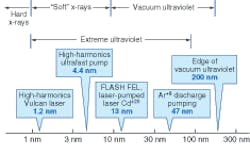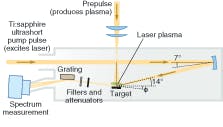PHOTONIC FRONTIERS: EXTREME-UV SOURCES: Coherent light sources reach the extreme-ultraviolet

The short-wavelength end of the ultraviolet spectrum is a part of the photonic frontier where the boundaries remain hazy. Functionally, this extreme-ultraviolet (EUV) region covers wavelengths from the edge of the x-ray spectrum to the point where conventional optical materials don’t work well. In practice, that is coming to mean 1 to 100 nm, but definitions do vary. Wavelengths to 10 nm are often called soft x-rays. The long end of the EUV is variously defined at 30 to 200 nm, the latter corresponding to the edge of the vacuum ultraviolet, where air becomes opaque.
Long neglected because it was difficult to produce or detect, the EUV has become important in semiconductor fabrication and in the laboratory because it allows high-resolution imaging and fabrication, and observation of strong resonances. Synchrotrons were the first sources of high-energy vacuum UV photons, and are still in use, but they are massive and tremendously expensive. Plasmas produced by laser pulses or electric discharges emit in the EUV; their incoherent output can be an advantage for applications such as photolithography because it avoids interference effects and speckle.
However, lasers and laser-like sources have their own advantages. Four main types have been demonstrated: free-electron lasers down to 13 nm, discharge-pumped highly ionized gas lasers at wavelengths down to 47 nm, laser-pumped pulsed lasers at wavelengths to near 13 nm, and high-order harmonics generation at wavelengths below 4 nm (see Fig. 1).
Free-electron lasers
Free-electron lasers offer the highest average power at the shortest wavelength, but they are built around particle accelerators, so those attractive features come at a steep price. In September, the Deutsches Elektronen-Synchrotron (DESY) in Hamburg, Germany, reported generating pulses at 13.5 to 13.8 nm with average energy of 70 μJ at a repetition rate of 150 Hz, yielding record average EUV energy of 10 mW. They reached that power level by accelerating electrons to one gigaelectronvolt in the 260-meter-long accelerator, then passing them through a 30 m undulator in a testbed called FLASH (free-electron laser at Hamburg). Individual pulses at the fundamental wavelength lasted 10 fs, with reported peak power of 10 GW. The system also generated third and fifth harmonics at 4.6 and 2.7 nm at lower powers.
Operational since August 2005, FLASH is tunable between fundamental wavelengths of 13.1 and 40 nm. Next year an upgrade will boost the tuning range to between 6 and 60 nm. Then DESY will begin work on the European X-Ray Laser project, a 3.4-km-long free-electron laser budgeted at €986 million in 2005 (US$1258), which will produce even shorter wavelengths when complete in 2013.1 The closest the U.S. now comes to an EUV free-electron laser is the Deep Ultraviolet Free-Electron Laser at the Brookhaven National Laboratory (Upton, NY) which has operated at 190 nm. However, the Linac Coherent Light Source under construction at the Stanford Linear Accelerator (Stanford, CA) is to emit hard x-rays at 0.15 to 1.5 nm when it begins operation in 2009.2
Laser-pumped lasers
The first clear demonstrations of EUV lasing were performed in 1984, by firing pulses from the Lawrence Livermore National Laboratory’s (Livermore, CA) Nova fusion laser at solid selenium targets, producing a highly ionized selenium plasma. The population inversion on inner-shell transitions at 20.6 and 20.9 nm produced high enough gain for single-pass lasing without a resonant cavity. Livermore called the demonstration a “soft x-ray” laser, and later extended the technique to shorter wavelengths by more highly ionizing other elements. (Results of a parallel Livermore program that sought to pump a shorter-wavelength x-ray laser with radiation from a nuclear explosion remain classified.) The tremendous power of fusion lasers made it possible to reach wavelengths below 6 nm in later experiments with the Rutherford Appleton Lab’s (Oxfordshire, England) Vulcan laser. However, fusion lasers can be fired only a few times a day, and like synchrotrons they fill buildings.
The next step was development of more-compact pump lasers with higher repetition rates, such as Livermore’s pioneering Petawatt laser (see www.LaserFocusWorld.com/articles/266389), which led to the first tabletop laser-pumped EUV lasers. Pumping schemes also have been refined to make the most of the available pump power. The pump energy needed to reach gain saturation on an EUV line can be reduced by first producing a highly ionized plasma, then directing the pump beam into it at a grazing angle. Refraction within the plasma then guides the pump beam along the length of the plasma, increasing the interaction length and energy deposition.Recent experiments have demonstrated EUV lasing in nickel-like ions of a series of elements says Jorge Rocca of Colorado State University, director of the NSF Engineering Research Center for Extreme Ultraviolet Science and Technology (Fort Collins, CO). A preliminary pulse first ionizes samples to produce the plasma. Then 8 ps, 1 J pulses from a solid-state Ti:sapphire laser are injected into the plasma at a grazing angle of 14° to 23° with a repetition rate of 5 Hz. In this arrangement the pulse strips away the outer shells of electrons from a series of elements, leaving only 28 electrons, called nickel-like ions because the remaining electrons correspond to the configuration of nickel (see Fig. 2). Blasting 16 electrons out of ruthenium atoms produced saturated gain from nickel-like Ru+16 ions at 16.5 nm in a single-pass laser. The shortest wavelength to date where they produced saturated gain is 13.2 nm, from nickel-like cadmium ions Cd+20.3 The researchers observed amplification-but not saturated gain-at lines as short as 10.9 nm, from nickel-like tellurium, Te+24.4
Discharge-pumped EUV lasers
Discharge pumping has yet to produce laser action at such short wavelengths, but it promises more-compact desktop EUV lasers. Current research is focused on delivering high power densities and producing a plasma uniform enough to sustain laser action.
Rocca’s group at Colorado State has been working on discharge excitation of argon at much higher energy levels-and greater degrees of ionization-than in visible and near-UV argon-ion lasers. Their pulsed discharges fire peak currents of 20 to 25 kA into an argon-filled capillary tube 3.2 mm in diameter and 20 to 30 cm long. The intense electrical pulse ionizes the gas to Ar+8 and compresses it into a column only 200 to 300 μm in diameter. Single-pass amplification produces microjoule pulses at 46.9 nm; Rocca says pulse energies have now reached 13 mJ at repetition rates to 12 Hz.5, 6 Measuring 0.4 × 0.8 × 0.8 m, including vacuum system, the demonstration laser has been used in spectroscopy experiments.
High-harmonic sources
High-order harmonic generation from visible or near-IR lasers also can generate coherent EUV light, and to date has produced the shortest wavelengths. The technique relies on focusing extremely high peak powers into a suitable gas. As laser intensities reach 1013 to 1016 W/cm2 the fields become strong enough to ionize atoms. At these power densities, the electrons follow complex paths, first moving away from the ion, then moving back toward it as the direction of the applied field changes. That strong oscillation generates high-order odd harmonics of the input laser frequency, but it took development of ultrashort pulse lasers with high peak power to generate the intense laser fields needed to produce practical levels of high harmonics.7
A second step was developing techniques for phase-matching the fundamental beam with the harmonics in a gas-filled hollow waveguide. Balancing the gas pressure so the waveguide dispersion canceled the dispersion from the un-ionized gas can match the harmonic phase with the fundamental to wavelengths longer than 15 nm. Modulating the intensity of an ultrashort laser pulse or the diameter of the waveguide allows quasi-phase-matching, which can extend high-harmonic generation to shorter wavelengths.8 Margaret Murnane and Henry Kapteyn’s group at the University of Colorado used this approach to generate harmonics up to about the 115th order, corresponding to a 4.4 nm wavelength.9 The high-harmonic beam can be made fully coherent, and the harmonic generation process itself compresses the EUV pulse because it occurs only when the pulse is at its peak power. Bigger lasers can go further. In July, an international team reported wavelengths down to 1.2 nm, corresponding to harmonics higher than the 850th order, from plasmas produced by the Vulcan Petawatt laser at the Rutherford Appleton Laboratory.10
Applications and outlook
The biggest potential application of EUV sources is the photolithographic printing of integrated circuits with extremely high density and fine resolution. Coherent sources are not desirable because they could produce speckle or J. interference, says Rocca. But laser sources are attractive for the precision measurements required. Extreme-UV lasers are also promising for a variety of spectroscopic tasks such as probing high-speed molecular processes, diagnostics of dense plasmas, attosecond physics, and nanoscale ablation and imaging. Reaching wavelengths shorter than 4 nm will allow probing of biological materials in the water window.
The giant systems powered by big accelerators or fusion lasers are likely to set the records. But the tabletop systems will make the technology much more widely available at far more reasonable costs.
REFERENCES
1. www.xfel.net
2. www-ssrl.slac.stanford.edu/lcls
3. J.J. Rocca et al., Optics Lett. 30, 2581 (Oct. 1, 2005).
4. Y. Wang et al., Phys. Rev. A 72, 053807 (2005).
5. C.D. Macchietto, et al., Optics Lett. 24, 1115 (Aug. 15, 1999).
6. S. Heinbuch et al., Optics Express 13, 4050 (May 30, 2005).
7. J. Zhou et al, Phys. Rev. Lett. 76, 752 (1996).
8. H. Kapteyn, M. Murnane, and I. Christov, Physics Today 58, 39 (March 2005).
9. E. Gibson et al., Science 302, 95 (Oct 3, 2003).
10. B. Dromey et al., Nature Physics 2, 456 (July 2006).

Jeff Hecht | Contributing Editor
Jeff Hecht is a regular contributing editor to Laser Focus World and has been covering the laser industry for 35 years. A prolific book author, Jeff's published works include “Understanding Fiber Optics,” “Understanding Lasers,” “The Laser Guidebook,” and “Beam Weapons: The Next Arms Race.” He also has written books on the histories of lasers and fiber optics, including “City of Light: The Story of Fiber Optics,” and “Beam: The Race to Make the Laser.” Find out more at jeffhecht.com.
